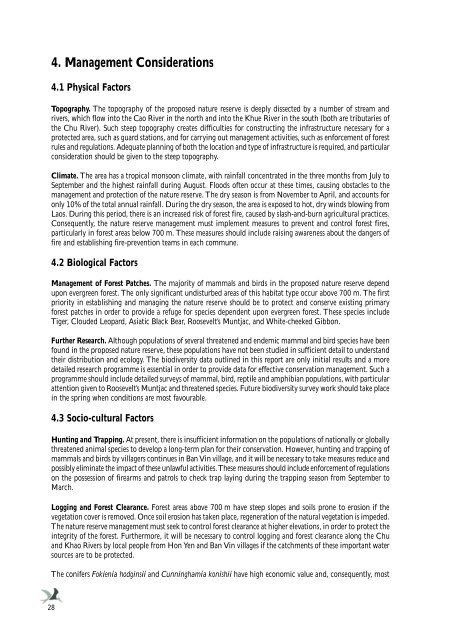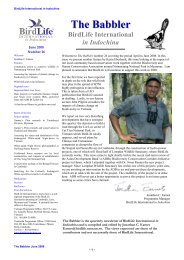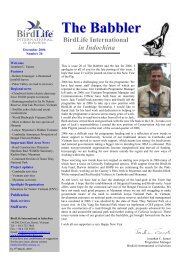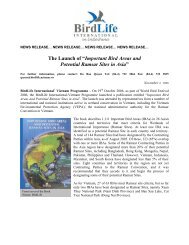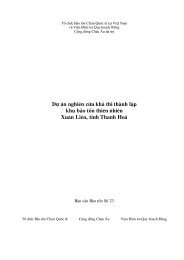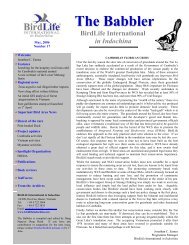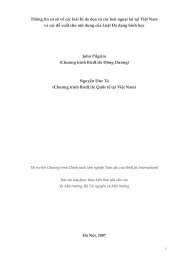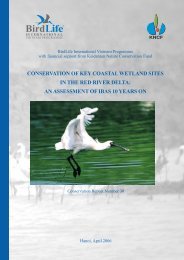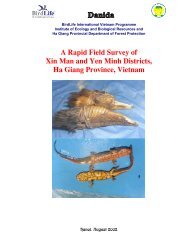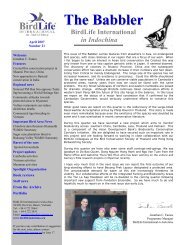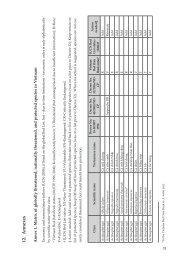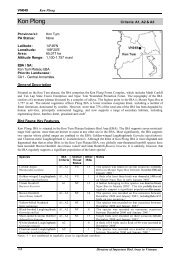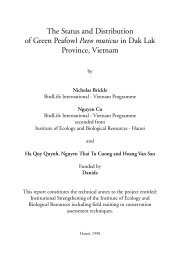A Feasibility Study for the Establishment of Xuan Lien Nature ...
A Feasibility Study for the Establishment of Xuan Lien Nature ...
A Feasibility Study for the Establishment of Xuan Lien Nature ...
You also want an ePaper? Increase the reach of your titles
YUMPU automatically turns print PDFs into web optimized ePapers that Google loves.
4. Management Considerations<br />
4.1 Physical Factors<br />
Topography. The topography <strong>of</strong> <strong>the</strong> proposed nature reserve is deeply dissected by a number <strong>of</strong> stream and<br />
rivers, which flow into <strong>the</strong> Cao River in <strong>the</strong> north and into <strong>the</strong> Khue River in <strong>the</strong> south (both are tributaries <strong>of</strong><br />
<strong>the</strong> Chu River). Such steep topography creates difficulties <strong>for</strong> constructing <strong>the</strong> infrastructure necessary <strong>for</strong> a<br />
protected area, such as guard stations, and <strong>for</strong> carrying out management activities, such as en<strong>for</strong>cement <strong>of</strong> <strong>for</strong>est<br />
rules and regulations. Adequate planning <strong>of</strong> both <strong>the</strong> location and type <strong>of</strong> infrastructure is required, and particular<br />
consideration should be given to <strong>the</strong> steep topography.<br />
Climate. The area has a tropical monsoon climate, with rainfall concentrated in <strong>the</strong> three months from July to<br />
September and <strong>the</strong> highest rainfall during August. Floods <strong>of</strong>ten occur at <strong>the</strong>se times, causing obstacles to <strong>the</strong><br />
management and protection <strong>of</strong> <strong>the</strong> nature reserve. The dry season is from November to April, and accounts <strong>for</strong><br />
only 10% <strong>of</strong> <strong>the</strong> total annual rainfall. During <strong>the</strong> dry season, <strong>the</strong> area is exposed to hot, dry winds blowing from<br />
Laos. During this period, <strong>the</strong>re is an increased risk <strong>of</strong> <strong>for</strong>est fire, caused by slash-and-burn agricultural practices.<br />
Consequently, <strong>the</strong> nature reserve management must implement measures to prevent and control <strong>for</strong>est fires,<br />
particularly in <strong>for</strong>est areas below 700 m. These measures should include raising awareness about <strong>the</strong> dangers <strong>of</strong><br />
fire and establishing fire-prevention teams in each commune.<br />
4.2 Biological Factors<br />
Management <strong>of</strong> Forest Patches. The majority <strong>of</strong> mammals and birds in <strong>the</strong> proposed nature reserve depend<br />
upon evergreen <strong>for</strong>est. The only significant undisturbed areas <strong>of</strong> this habitat type occur above 700 m. The first<br />
priority in establishing and managing <strong>the</strong> nature reserve should be to protect and conserve existing primary<br />
<strong>for</strong>est patches in order to provide a refuge <strong>for</strong> species dependent upon evergreen <strong>for</strong>est. These species include<br />
Tiger, Clouded Leopard, Asiatic Black Bear, Roosevelt’s Muntjac, and White-cheeked Gibbon.<br />
Fur<strong>the</strong>r Research. Although populations <strong>of</strong> several threatened and endemic mammal and bird species have been<br />
found in <strong>the</strong> proposed nature reserve, <strong>the</strong>se populations have not been studied in sufficient detail to understand<br />
<strong>the</strong>ir distribution and ecology. The biodiversity data outlined in this report are only initial results and a more<br />
detailed research programme is essential in order to provide data <strong>for</strong> effective conservation management. Such a<br />
programme should include detailed surveys <strong>of</strong> mammal, bird, reptile and amphibian populations, with particular<br />
attention given to Roosevelt’s Muntjac and threatened species. Future biodiversity survey work should take place<br />
in <strong>the</strong> spring when conditions are most favourable.<br />
4.3 Socio-cultural Factors<br />
Hunting and Trapping. At present, <strong>the</strong>re is insufficient in<strong>for</strong>mation on <strong>the</strong> populations <strong>of</strong> nationally or globally<br />
threatened animal species to develop a long-term plan <strong>for</strong> <strong>the</strong>ir conservation. However, hunting and trapping <strong>of</strong><br />
mammals and birds by villagers continues in Ban Vin village, and it will be necessary to take measures reduce and<br />
possibly eliminate <strong>the</strong> impact <strong>of</strong> <strong>the</strong>se unlawful activities. These measures should include en<strong>for</strong>cement <strong>of</strong> regulations<br />
on <strong>the</strong> possession <strong>of</strong> firearms and patrols to check trap laying during <strong>the</strong> trapping season from September to<br />
March.<br />
Logging and Forest Clearance. Forest areas above 700 m have steep slopes and soils prone to erosion if <strong>the</strong><br />
vegetation cover is removed. Once soil erosion has taken place, regeneration <strong>of</strong> <strong>the</strong> natural vegetation is impeded.<br />
The nature reserve management must seek to control <strong>for</strong>est clearance at higher elevations, in order to protect <strong>the</strong><br />
integrity <strong>of</strong> <strong>the</strong> <strong>for</strong>est. Fur<strong>the</strong>rmore, it will be necessary to control logging and <strong>for</strong>est clearance along <strong>the</strong> Chu<br />
and Khao Rivers by local people from Hon Yen and Ban Vin villages if <strong>the</strong> catchments <strong>of</strong> <strong>the</strong>se important water<br />
sources are to be protected.<br />
The conifers Fokienia hodginsii and Cunninghamia konishii have high economic value and, consequently, most<br />
28


